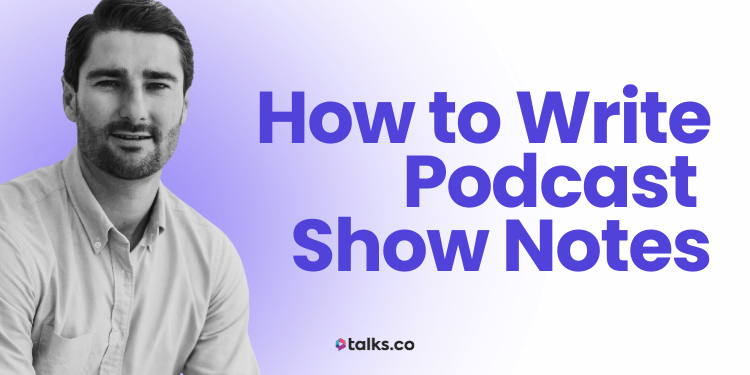You’ve put in the work: recorded the episode, edited the audio, hit publish. But now you’re staring at it thinking: “How do I actually get people to press play?”
That’s where podcast show notes come in.
Most hosts skip them, or throw a couple of lazy lines together, and wonder why listeners tune out. But when you get them right, writing show notes can be the difference between someone scrolling past your episode description or stopping to listen.
I’ve been on hundreds of shows and interviews and worked with hosts across every niche you can think of. The ones who grow fastest all have one thing in common: they take their show notes seriously.
And in this step-by-step guide, I’ll show you how to do the same.
What Are Podcast Show Notes?
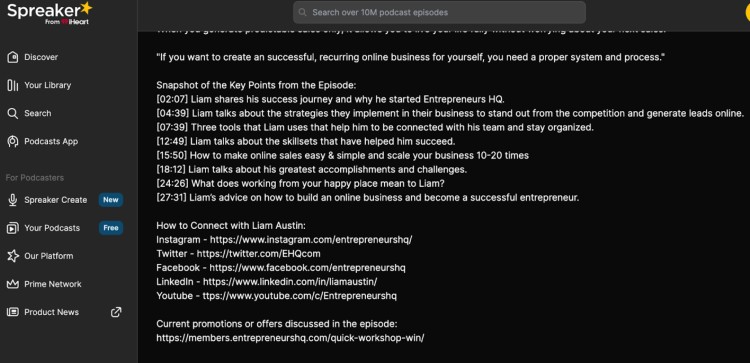
Podcast show notes are the written breakdown of your episode. They tell people what they’re about to hear, who’s in it, and why they should stick around.
Let’s say someone’s scrolling through Spotify on the train. They see your episode title, but they’re not sure if it’s worth 40 minutes of their time.
Your show notes are the thing that makes them think, “Yep, this is exactly what I need right now.”
They usually cover:
- A quick podcast summary of the episode
- Guest details and links
- Main talking points or timestamps
- Any resources, affiliate links, freebies, or offers you mention
It’s not a full transcript. It’s not a throwaway line. It’s the podcast description that makes your podcast easier to find and share.
Where to find podcast show notes
You’ll see show notes:
- On podcast apps: Podcast directories and platforms like Apple Podcasts, Spotify, and Google Podcasts all display your notes right under the episode title.
- On your website: Many podcasters publish them as a blog post to rank on Google
- In emails or newsletters: Great for teasing an episode with key topics, highlights, and links to resources.
- Embedded players: If you share your podcast through a player on social media or your podcast website, the notes usually show there too.
If you’re a business coach with an episode on “how to price your services,” potential listeners might find your show just by Googling that phrase all because it’s in your show notes on your site.
10 Benefits of podcast show notes

When done right, great show notes do a lot more than just summarize your episode. They help your podcast listeners decide fast, give your podcast more reach, and turn each episode into audio content that actually works for you.
- Help people decide quickly: Think about the coach scrolling through podcasts before the gym. Your notes tell them, “This episode is for you.”
- Get picked up by Google: Drop podcast SEO keywords naturally in your notes and suddenly new listeners are finding you from search results without you lifting another finger.
- Save listeners chasing links: Mentioned a book, framework, or offer? Put it in the notes. No one’s scrubbing back through audio to catch that URL.
- Make your podcast guests look good: Add a short bio, socials, and site. They’ll share it on their social media posts because it shines a light on them too.
- More shareable content: A strong summary makes it easy for someone to copy a line or link and drop it on LinkedIn or Twitter.
- Drive traffic back to you: Add links to your coaching page, lead magnet, or community. Show notes can pull listeners deeper into your world.
- Keep people hooked with timestamps: Example: “Skip to 18:20 for the bit on landing high-ticket clients.” Gold for listeners who want to jump straight to the good stuff.
- Reach people who prefer reading: Some people scan before they commit. Notes let them decide faster and often push them to hit play.
- Fuel for repurposing: Your notes can be turned into Instagram captions, LinkedIn posts, or emails. Work once, use everywhere.
- Look sharp, build trust: Clean, consistent show notes signal that you’re running a professional show and something worth subscribing to.
If you’re curious about episode length and what works best for your audience, check out this guide on how long a podcast should be here.
Best Podcast Show Notes Format
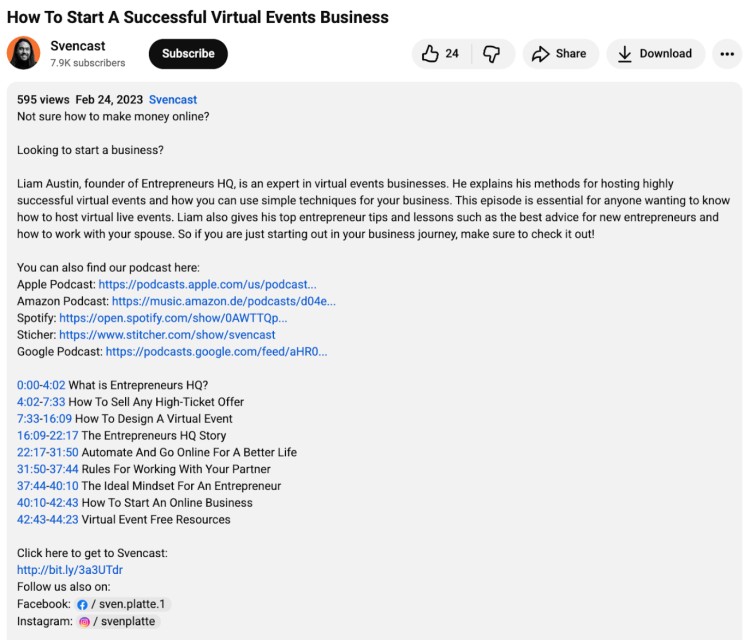
Let’s take a real-world example: the show notes from How To Start A Successful Virtual Events Business on Svencast. The host put together show notes that highlight a lot of what works.
Why these podcast show notes work:
- Strong opening hook: Right away, it speaks to the listener’s pain point: “Not sure how to make money online? Looking to start a business?” That’s direct and pulls in anyone who’s searching for answers.
- Episode value upfront: The copy teases exactly what listeners will learn: how to host events, sell high-ticket offers, work with your spouse. That’s clear and practical.
- Detailed timestamps included: Super useful for skim-readers who just want to jump to the good part and boosts SEO (search engine optimization) with all those topic keywords.
- Links to platforms: They make it easy for people to listen on any major platform they prefer. Learn how to cite a podcast properly here.
- Guest credibility: The notes establish authority by highlighting my experience in virtual events which gives people a reason to hit play.
Podcast show notes example
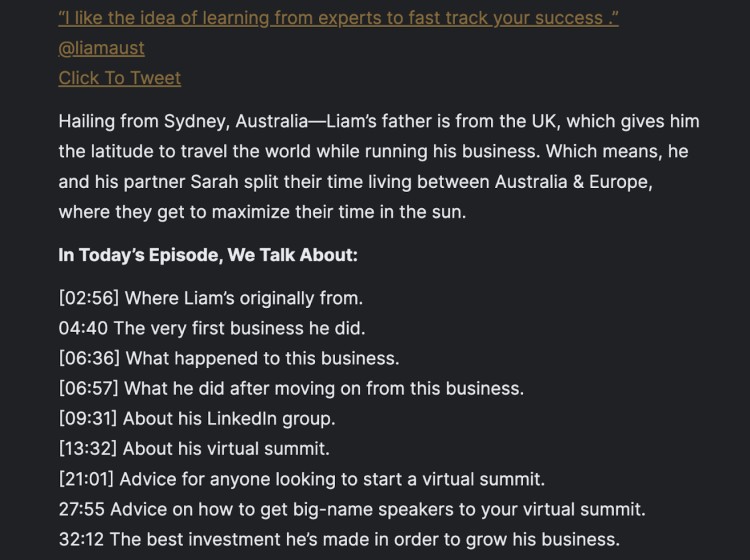
Good show notes pull people in, make you look legit, and get your episode discovered. Here are real examples of podcast show notes to picture how it works:
- The Biz Book Broadcast: Quick summary that hooks with the benefit: why guesting on podcasts can grow your business. Links to my site, free guide, and reading list. Clear, easy to skim, and packed with value.
- The Social Media Takeaway: Blog-style write-up with 7 key takeaways. Perfect for action-focused readers who want steps fast.
- Smooth Business Podcasting: “What you’ll learn” list plus timestamps so listeners can jump straight to the gold moments. Context on why guesting matters makes it compelling.
- Work From Your Happy Place: Guest bio first, then key points with timestamps. Works well if your audience likes structure and detail.
- The Side Hustle Project: Clean and simple. Intro summary, discussion highlights, and links to connect. Sometimes simple is best.
Notice how each one looks a bit different, but they all do the same job: hook listeners and show value while giving search engines plenty to latch onto.
Check out my guide on podcast description examples and the free Talks description generator for more ideas.
Podcast show notes images
Text alone works, but adding visuals makes your notes pop. Here are ways different types of podcasts use images in their show notes:
- Episode artwork: A square cover image for each episode makes your notes instantly recognizable across platforms.
- Guest headshots: Helps listeners put a face to the voice and adds professionalism.
- Graphics or pull-quotes: A well-designed quote image (“547M podcast listeners worldwide”) is highly shareable on social.
- Screenshots of resources: If you mention a book, tool, or template, a screenshot adds clarity and saves your audience time.
Adding images isn’t about decoration. It’s about making your show notes stand out, feel more trustworthy, and give people an extra nudge to share.
How to Write Podcast Show Notes
Making show notes doesn’t need to take hours. Here’s how to get it done quickly:
- Listen and jot: Listen to your show and quickly note the main points or standout quotes from your podcast transcript. No need to transcribe everything.
- Summarize key insights: Capture your guest’s biggest takeaways in a few sentences. Make it easy for someone to scan and know what’s valuable.
- Add timestamps in your show notes: Point listeners to the gold moments. Actionable tips, jokes, or insights they won’t want to miss.
- Include links and resources: Drop in the books, tools, or programs mentioned. Make it effortless for listeners to follow up.
- Polish fast: Keep your show notes simple. Break up paragraphs, use bullets, bold headings. Quick formatting makes a huge difference.
You can also use podcast outline templates to keep your notes structured and easy to follow here.
Talks podcast show notes generator
If you want fast, structured, ready-to-use notes, the Talks generator is a solid option.
Just drop in your episode info, guest details, and key talking points, and it generates show notes that are easy to publish.
Why it works:
- Time saver: Generates notes in minutes instead of hours.
- Consistent podcast format: Keeps your episodes looking professional.
- SEO-ready: Keywords and structure baked in for discoverability.
Talks podcast show notes generator free results
Even without a paid account, you can test the generator to see how your notes could look. It gives a real sense of the structure and content, so you can tweak or expand them to fit your voice.
Here’s what I put in:
- Episode link: https://www.youtube.com/watch?v=MRFql2BlbE4
- Episode title: 7 Questions in 7 Minutes with Liam Austin: Virtual Events That Sell
- Host: Tim Marshall
- Guest: Liam Austin
Topics:
- How to build authority and grow your audience with virtual events
- Converting virtual event attendees into high-ticket clients
- Common mistakes entrepreneurs make when launching virtual summits
Here’s what the Talks podcast show notes generator gave:
Episode summary:
Learn how to build authority and grow your audience with virtual events, convert attendees into high-ticket clients, and avoid common mistakes when launching virtual summits.
Key takeaways:
- Use virtual events to build authority and grow your audience.
- Convert attendees into high-ticket clients with valuable content.
- Avoid the common pitfalls when hosting summits.
- Focus on engagement and networking.
- Follow up strategically to close sales.
Timestamps:
- 00:00 – Intro to the power of virtual events
- 01:30 – Building authority through virtual events
- 03:45 – How to convert attendees into clients
Try it yourself and see how quickly you can turn your episode info into ready-to-publish, professional show notes. It literally takes less than a minute.
Free AI podcast show notes prompts
AI can save hours if you give it clear instructions. Try these fill-in-the-blank prompts to help write your show notes faster:
- Episode summary: “Summarize my podcast episode [Episode Title] with [Guest Name]. Cover these topics: [Topic 1, Topic 2, Topic 3] in 3-4 engaging sentences.”
- Key takeaways: “List 5 practical takeaways from [Episode Title] with [Guest Name]. Keep them actionable to engage listeners.”
- Timestamps: “Create timestamps with short descriptions for each segment of [Episode Title] featuring [Guest Name].”
- Guest bio: “Write 2-3 sentences about [Guest Name], including their expertise in [Field] and one unique fact.”
- Call-to-action: “Write a punchy CTA encouraging listeners to subscribe, leave a review, or visit [Link].”
Use these prompts as a base, then add your own personality, humor, or extra context so the show notes sound like you, not a template.
What to Include In Your Show Notes
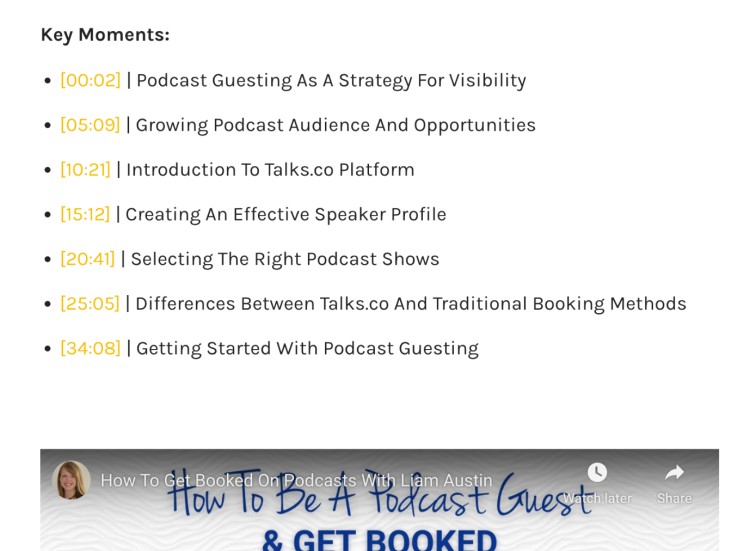
A good set of show notes gives your listener everything they need at a glance. Here’s what to pack in:
- Episode summary: A short, punchy rundown of what the episode covers. Give them a reason to press play in a few lines.
- Guest details: Name, bio, socials, and website. Makes it easy for listeners to connect and gives your guest extra exposure.
- Timestamps: Highlight the key moments or advice. Think: “Skip to 12:30 for the bit on closing clients fast.”
- Links and resources: Books, tools, courses, or websites mentioned. Stop listeners from scrubbing back to catch URLs.
- Call to action: Tell them what to do next like sign up for your newsletter, check out a program, or follow your show or socials.
How to create podcast show notes
You can write them one episode at a time or batch them. Both work, but here are some more practical approaches:
- Batch writing: Record a few episodes, then write all the notes at once. Keeps your style consistent and saves time.
- Write per episode: Draft straight after recording. Ideas are fresh, notes are sharper.
- Use templates or podcast tools: Track timestamps as you record. A repeatable structure makes it quicker next time.
- Stay consistent: Regular, well-formatted notes build trust and make your podcast feel professional.
How to make podcast show notes your own
Your show notes pages don’t have to be boring bullet points. It’s about making your podcast notes unmistakably you to engage listeners and promote your podcast:
- Voice and tone: Write like you talk on the mic. Blunt? Witty? Straightforward? Make it unmistakably yours.
- Storytelling hooks: Drop anecdotes, mini-stories, or quick examples that connect to the episode. Keeps readers hooked.
- Signature phrasing: Use a consistent intro or wrap-up style. Over time, people will recognize your notes instantly.
- Extra flair: Pull-quotes, branded phrases, or subtle humor can make your notes stand out without overdoing it.
- Audience-first tweaks: Think: what makes your listener nod, laugh, or click play? Write for them, not yourself.
This is where you stamp your personality. Everything else (links, formatting, keywords) is the skeleton. This is the muscle and character.
5 Podcast show notes best practices
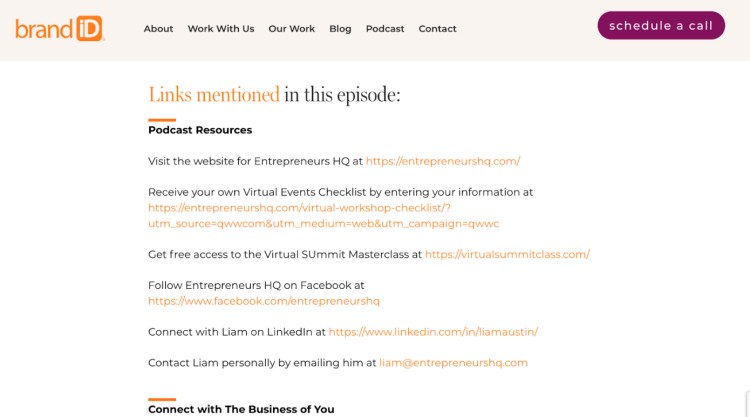
Little tweaks to your show notes can also go a long way. Keep these practices in mind to make your notes readable, useful, and easy to discover:
- Keep it scannable: Bullets, bold headings, short paragraphs. People shouldn’t need to scroll forever to get the value.
- Lead with value: Put the hook at the top. Make them think, “Yeah, I want to hear this.”
- Include keywords naturally: Helps new listeners find your episodes without looking forced.
- Link strategically: Only add links that matter. Too many, and it feels messy.
- Proofread once: No typos, clear flow, looks professional. That’s it.
Podcast Show Notes Template
Use this as a starting point for every episode. Fill in the blanks, tweak the wording to match your voice, and make it yours.
Podcast episode details:
- Episode title: [Insert catchy title that grabs attention]
- Episode number: [E01, E02…]
- Release date: [MM/DD/YYYY]
- Guest name: [Full name]
- Guest bio: [2-3 lines on their background, expertise, and credibility]
- Episode summary: [3-5 sentences summarising what the episode covers and why listeners should care]
Key takeaways/timestamps:
- [00:00] Intro + context
- [05:30] Main tip #1
- [12:45] Main tip #2
- [20:15] Guest insight/story
- [30:00] Actionable step for listeners
Resources mentioned: [Books, tools, courses, links]
Call to action: [Subscribe, join newsletter, grab a free resource, etc.]
Podcast show notes template PDF
Here’s a version you can use as a downloadable fill-in-the-blank PDF structure:
Title: [Your episode title here]
Episode number and date: [E01 | MM/DD/YYYY]
Guest name and bio: [Name] – [2-3 sentences on expertise]
Summary:
- What’s this episode about? [Short punchy intro]
- Why should people listen? [Key benefits/outcomes]
Timestamps/Highlights:
- [00:00] Introduction
- [05:00] Main discussion point #1
- [10:30] Guest story/tip
- [20:00] Key takeaway/action step
Resources and links:
- [Books, tools, websites, programs mentioned]
Call to action:
- [Next step for listeners]
More Than Just a Footnote
Podcast show notes are your hidden leverage. Done right, they don’t just describe an episode.
They sell it, make it discoverable, and set the stage for conversations that actually matter. They give your listeners clarity and your show credibility, all before they hit play.
But here’s the thing: finding the right guests and keeping your calendar full? That’s where most hosts hit a wall.
Instead of scrambling for names or hoping someone amazing reaches out, you can take control.
With a free Talks creator profile, you get matched with guests who bring energy, stories, and insight. Every. Single. Time.
Stop guessing. Stop chasing. Start booking guests who make your audience come back for more.
Create your free Talks Creator profile now.
